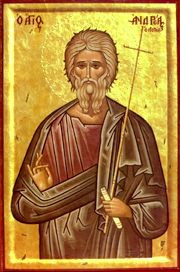Apostle Andrew
The holy, glorious and all-laudable Apostle Andrew the First-Called was the first of the apostles of Jesus Christ and the brother of the Apostle Peter. His great missionary legacy led him to become the patron saint of several countries, including Romania and Scotland. His feast day is November 30.
Life
Andrew was a fisherman by trade, born in Bethsaida. A disciple of John the Forerunner, he left St. John to follow Jesus Christ following his baptism and brought along his brother, the Apostle Peter. Both are numbered among the Twelve Great Apostles. After Pentecost, the lot fell to St. Andrew to preach in:
- Byzantium: he appointed St. Stachys as its first bishop
- Thrace, Peloponnese, Greece, and Epirus: he converted many to the Faith and ordained bishops and priests for them
- Georgia: he entered Georgia from Ajara, preached Christianity in Atsquri, built small church there and left miracle-working icon of Theotokos.
- Rus' lands: in Kiev he planted a cross on one of the high hills of Kiev, and he prophesied a city that would have many golden-domed churches, and a bright Christian future for the Rus' people.
Martyrdom
St. Andrew was martyred in Peloponnese, in the city of Patras.
The Lord worked many miracles through His disciple in Patra from where the Apostle preached throughout all Achaia. The infirm were made whole, and the blind received their sight. Through the prayers of the Apostle, the illustrious citizen Sosios recovered from serious illness and Maximilla and Stratokles, the wife and brother of the governor of Patra, were healed. The miracles accomplished by the Apostle, and his fiery sermons enlightened almost all the citizens of the city of Patra, bringing them to the True Faith.
Few pagans remained at Patra, but among them was the prefect of the city, Aegeates. The Apostle Andrew repeatedly turned to him with the words of the Gospel. But even the miracles of the Apostle did not convince Aegeates. Caring only for the prefect’s salvation, the holy Apostle appealed to him with love and humility, striving to reveal to him the Christian mystery of eternal life, through the lifegiving power of the Holy Cross of the Lord. The angry Aegeatos gave orders to crucify the apostle. The pagan thought he might undo Andrew’s preaching if he were to put him to death on the cross.
Saint Andrew the First-Called accepted the decision of the prefect with joy and with prayer to the Lord, and went willingly to the place of execution saying, “O, good Cross, made beautiful by the body of my Lord. So long desired, so anxiously loved, so unceasingly sought after, and now at last ready for my soul to enjoy! Take me from amidst men, and restore me to my Master, that by you He may receive me, who by you redeemed me.”
In order to prolong the suffering of the saint, Aegeates gave orders not to nail the saint’s hands and feet, but to tie them to an X-shaped cross. For two days the apostle taught the citizens who gathered about. The people, in listening to him, with all their souls pitied him and tried to take the saint down from the cross. Fearing a riot of the people, Aegeates gave orders to stop the execution. But the holy apostle began to pray that the Lord would grant him death on the cross. Just as the soldiers tried to take hold of the Apostle Andrew, they lost control of their hands. The crucified apostle, having given glory to God, said: “Lord Jesus Christ, receive my spirit.” Then a blazing ray of divine light illumined the cross and the martyr crucified upon it. When the light faded, the holy Apostle Andrew had already given up his holy soul to the Lord. It was the year 62 AD.
Maximilla, the wife of the prefect, had the body of the saint taken down from the cross, and buried him with honour, and lived out the remainder of her days in faith.
Relics
St. Andrew's relics were transferred from Patra to Constantinople and placed in the church of the Holy Apostles, while a hand was taken to Moscow. The Crusaders stole the relics and cross of Saint Andrew during the sacking of Constantinople, however, in a gesture of goodwill, Pope Paul VI presented the skull of the saint back to the Greek Orthodox Church in 1964, while the cross of the saint was returned in 1980. The saint’s relics and cross are now venerated in the magnificent church of Saint Andrew in Patra at the place of his martyrdom.
Hymns
Troparion (Tone 4)
- As the first-called of the Apostles
- and brother of the foremost disciple,
- Andrew, entreat the Master of all
- to grant peace to the world
- and to our souls great mercy.
Kontakion (Tone 2)
- Let us praise Andrew, the herald of God,
- the namesake of courage,
- the first-called of the Savior's disciples
- and the brother of Peter.
- As he once called to his brother, he now cries out to us:
- "Come, for we have found the One whom the world desires!"
Source
- St. Nikolai Velimirovic, The Prologue of Ohrid
See also
External links
Categories > Church History
Categories > Church History
Categories > Church History
Categories > Church History
Categories > Liturgics > Feasts
Categories > Liturgics > Feasts
Categories > Liturgics > Feasts
Categories > Liturgics > Feasts
Categories > People > Saints
Categories > People > Saints > Biblical Saints
Categories > People > Saints > Martyrs
Categories > People > Saints > Saints by century > 1st-century saints
